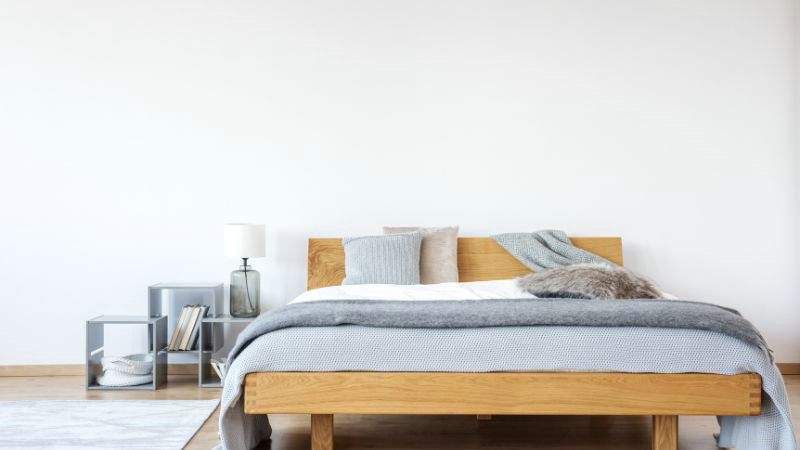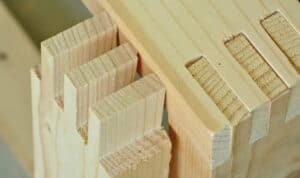
A squeaky bed frame can be incredibly annoying, disrupting your sleep. The persistent creaking and groaning noises every time you move in bed can make it difficult to get a restful night’s sleep.
In this article, we’ll explore the various factors that can cause a wooden bed frame to squeak.
Additionally, we’ll provide actionable tips for how to identify the source of a squeak in a wooden frame and the best methods to fix it yourself. With some basic tools and techniques, you can restore your wooden bed frame to silent operation so you can sleep peacefully through the night once again.
Why My Bed Frame Squeaks and How to Fix It
Squeaky beds can be a nuisance, interrupting a good night’s sleep. The causes of a squeaky bed can be various. This section explains why your bed might be making noise and commonly how to fix a squeaky bed, from loose fixtures to natural changes in the material.
Loose Joints and Screws
The stability of your bed depends on the tightness of joints and screws. Over time, these can loosen, causing parts of the bed frame to move slightly against each other when you shift your weight. Regularly inspect and tighten any loose screws to minimize noise.
- Tools to use: Wrench, Screwdriver
- Tip: Check all bolts and connection points. Tighten any loose bolts and screws, but not overtighten.
Broken Slats
If any of the wooden slats supporting the mattress are cracked or broken, they can rub and cause noise.
- How to do: Use small pieces of cork to fill gaps in loose joints.
Friction and Wood Expansion
Wooden bed frames may squeak due to friction where parts rub together, or because of expansion and contraction due to changes in weather. In warm and humid conditions, wood expands; when it’s cold, it contracts, which can create gaps that produce a squeak.
- How to do: Lubricate the joints with wax, soap, or paraffin to reduce friction between wooden parts.
Worn-Out Box Springs Issues
Old box springs with worn out or loose coils can rub against each other and cause squeaking. Replacing the box spring may be necessary.
- How to do: Replace your box spring if necessary.
How to Identify the Source of Squeaking

To effectively troubleshoot a squeaky wooden bed frame, it’s critical to identify exactly where the noise originates from. The key is to remove the mattress, then apply pressure to different points across the entire bare bed frame, listening carefully to hone in on the exact spot generating the squeak.
Joints, slats and legs/feet tend to be the most common trouble areas. A thorough inspection will reveal if the issue stems from loose hardware, uneven frame setup, or rubbing wood parts
Step 1: Remove the mattress from the bed frame so you can access and inspect the frame directly.
Step 2: Systematically apply pressure or rock different parts of the bare bed frame, including the headboard, footboard, side rails and slats. Have a partner help if needed – one person can apply pressure while the other listens for squeaks.
Step 3: Pay close attention and try to pinpoint the exact location the squeak is coming from as you put weight on different spots.
How to Preventing Future Squeaks
Regular maintenance of your wooden bed frame is essential to prevent squeaks and creaks. By tightening hardware, applying appropriate lubricants, and inspecting for wear, you’ll ensure longevity and a restful night’s sleep.
Every few months, take the time to check the bolts and screws of your bed frame. Ensure they’re tightened securely, but be careful not to strip the threads. Furthermore, look for any screws that may have loosened over time and give them a firm, but not forceful, tighten.
Applying a lubricant or wax to the parts where wood meets wood frequently, but avoid over-applying products, as excess can attract dust and create buildup.
At the same time, rotating your mattress can extend its life and prevent uneven wear, which may contribute to squeaking. You can rotate every 3-6 months to distribute wear evenly. If your mattress has been used for a long time, you can consider replacing it. Typically, it is replaced every 7-10 years, depending on the type and usage.
How to Choose a High-Quality Wooden Bed

When you’re in the market for a new bed, it’s crucial to consider the interplay between the bed frame, mattress, and support system. These elements can significantly influence whether you’ll end up with a restful night’s sleep or a creaky experience.
- Type of wood – Hardwoods like oak, mahogany, walnut, maple, and cherry are the most durable and long-lasting choices for bed frames. They offer superior strength, resistance to wear, and timeless beauty compared to softwoods like pine or cedar.
- Construction quality – Look for bed frames made with sturdy mortise and tenon or dovetail joints rather than just butt joints or nails/screws. Thicker, vertical wooden slats will provide better mattress support than thin, horizontally oriented slats.
- Brand reputation – Choose a reputable furniture brand or manufacturer known for using legally sourced, high-quality timber and expert craftsmanship. Hoolnn has maintained a strong focus on wooden furniture through the years with very carefully hand-crafted. If you are finding high quality wooden beds please contact us.
- Bed slats and supports – Slats too far apart can cause amattress to sag, leading to squeaks. So, it should be no more than 2-3 inches apart for optimal support.
- Center Support – Choosing a wooden bed that has good center support is essential for larger beds to prevent sagging and reduce noise.
Frequently Asked Questions
Is it common for my new wooden bed to creak?
Your new wooden bed frame might be noisy because the joints are settling or there could be friction in areas where the wooden parts meet. Make sure the connections are tight and well aligned might solve the issue.
Which lubricants work well for a creaky wooden bed?
Beeswax or paraffin wax can work wonders on a wooden bed. They create a lubricating layer that can reduce noise from wood-on-wood contact.
Can wax help reduce noise from a squeaky bed frame?
Yes, wax can be helpful. By rubbing wax on the areas where there’s friction, you can create a smooth barrier that prevents the wood pieces from rubbing against each other and squeaking.
Do bed frames made of wood or metal tend to squeak more?
Wooden bed frames are more prone to squeaking due to wood expanding and contracting with changes in humidity. Metal frames can also squeak, but this is typically due to loose bolts or joints that need lubrication.
Are there any quick fixes for a squeaky wooden bed frame?
A quick fix for a squeaky bed frame includes tightening any loose screws or bolts. You can also sprinkle talcum powder on the joints to provide a temporary buffer against noise.
Are wooden more likely to squeak?
While both wooden and metal bed frames have the potential to squeak, well-made wooden frames are generally considered more sturdy, less prone to noisy metal-on-metal friction, and less likely to develop squeaks compared to metal frames. However, the quality of materials and construction is an important factor for both types of bed frames.
I did everything to fix my bed, but it still squeaked; how should I do?
If you’ve tried all solutions and still can’t fix the squeak, it might be time to purchase a new bed frame.






